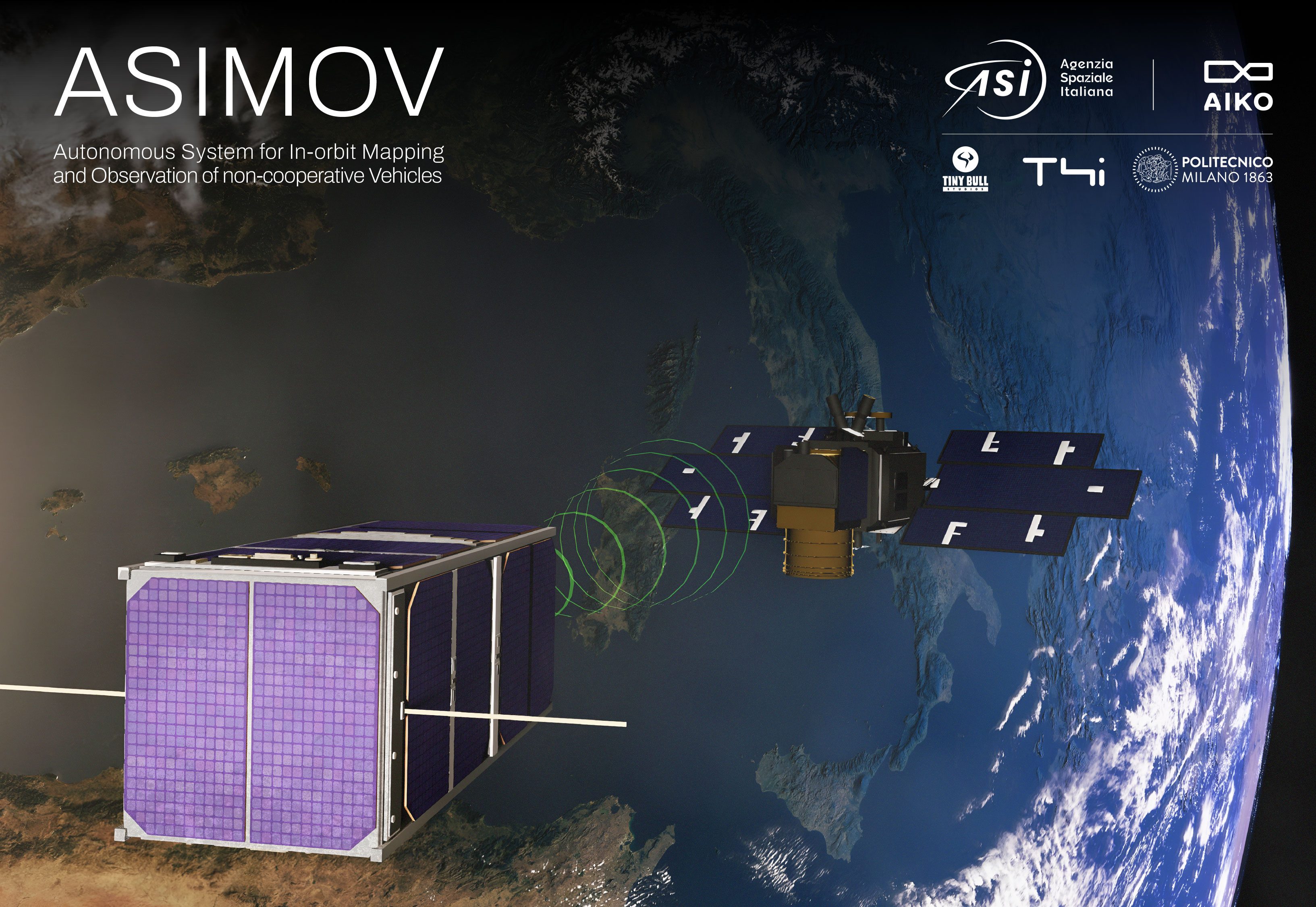
ASIMOV Turning the Unknown into the Mapped
AIKO is proud to lead ASIMOV (Autonomous System for In-orbit Mapping and Observation of non-cooperative Vehicles), an ambitious two-year project funded by the Italian Space Agency (ASI). ASIMOV tackles one of the most complex and safety-critical challenges in today’s space environment: enabling autonomous mapping of non-cooperative objects in Low Earth Orbit (LEO).
The project brings together a high-profile consortium including Politecnico di Milano, T4i, and Tiny Bull Studios, with the shared goal of pushing the boundaries of in-orbit autonomy through advanced AI technologies.
A Strong Partnership Across Expertise
Each member of the ASIMOV consortium plays a strategic and complementary role:
- AIKO, as project coordinator, leads the design and development of the autonomous GNC software system, leveraging its proprietary expertise in artificial intelligence and onboard autonomy.
- Politecnico di Milano with ASTRA research lab, plays a key role in the development and operation of ITS robotic testing facility, which is essential for validating the ASIMOV system and achieving TRL 5. The university also provides scientific guidance and supports the exploration of advanced GNC methodologies, particularly in navigation algorithms.
- T4i (Technology for Propulsion and Innovation) contributes with its knowledge in space propulsion systems and supports the definition of realistic In-Orbit Servicing (IOS) mission scenarios.
- Tiny Bull Studios, specialized in immersive digital experiences, supports the realism of the simulation environment by developing high-fidelity 3D renderings of the robotic facility and target objects.
A New Frontier in Onboard Autonomy
At the heart of ASIMOV is the development of an AI-based autopilot system, a smart Guidance, Navigation, and Control (GNC) architecture capable of inspecting and mapping objects in space without human intervention. This includes satellites that are non-cooperative, such as defunct spacecraft or debris, which present unique risks and require precise proximity operations.
ASIMOV’s vision is to lay the groundwork for future In-Orbit Servicing (IOS) missions, where autonomous systems will be key to inspection, maintenance, and debris mitigation efforts. The software will integrate state-of-the-art AI algorithms to boost autonomy, flexibility, and operational safety.
Building a Strategic Testing Infrastructure
To support system verification and validation, the project will enhance the ARGOS testing facility, a robotic infrastructure owned by ASTRA lab at Politecnico di Milano – Aerospace Science and Tech Dept - designed to emulate space conditions on Earth. The upgraded facility will provide a testbed for hardware-in-the-loop simulations, ensuring a reliable and reproducible environment to train and test AI and Machine Learning algorithms.
This dual-track approach—system development and testing infrastructure—positions ASIMOV as a strategic asset for the European space sector, especially in advancing the Technology Readiness Level (TRL) of AI-based autonomy from lab to orbit.
How It Works: Inside ASIMOV’s Technological Core
At a technological level, ASIMOV is structured around two parallel development paths: the AI-powered GNC system, and the enhancement of a robotic testing infrastructure for its validation.
The GNC system is built by combining modular AI components for perception and action, each designed to process sensory inputs, make autonomous decisions, and execute precise maneuvers during proximity operations. The software integrates Deep Neural Networks (DNNs) for vision-based navigation and Reinforcement Learning (RL) strategies to refine guidance and control logic. These elements are progressively merged and tested to evolve into a fully autonomous onboard autopilot.
In parallel, the robotic testing path ensures that each software module is validated in realistic, reproducible conditions. This includes a chain of simulations, from digital models to hardware-in-the-loop tests, culminating in experimentation within a dedicated robotic facility. The entire stack is developed with iterative feedback loops, aligning simulation results with physical behavior and progressively increasing the system’s Technology Readiness Level.
Together, these two tracks allow ASIMOV to move from theoretical models to a fully operational prototype, demonstrating real autonomy in space scenarios that have, until now, relied heavily on ground control.
Scientific Innovation in AI for Space
ASIMOV also carries a strong research component. The team will explore hybrid navigation approaches that combine classical techniques with Deep Neural Networks (DNNs), as well as Reinforcement Learning (RL) for autonomous guidance. These technologies promise to improve robustness and generalization across a wide range of mission scenarios, pushing forward the role of AI in space robotics.
Delivering Tangible Innovation
By the end of the project, ASIMOV will deliver a fully integrated, AI-based GNC system capable of autonomously performing mapping operations of non-cooperative objects in LEO. This will include a complete software stack with perception and action modules, tested and validated within a dedicated robotic facility up to TRL 5, ensuring readiness for future in-orbit demonstration missions.
In parallel, the upgraded ARGOS facility at Politecnico di Milano will remain as a long-term asset, providing a unique and scalable environment to test and train intelligent space systems.
Toward a More Sustainable Orbital Environment
In a time when LEO is becoming increasingly congested, ASIMOV directly supports a safer and more sustainable use of space. By enabling smarter, autonomous spacecraft operations, the project aims to reduce the operational burden on ground stations and mitigate risks linked to debris and defunct satellites.
ASIMOV aligns with the principles of the Zero Debris Charter, of which AIKO is a signatory, reinforcing our commitment to making space operations cleaner, safer, and more responsible.
Discover more: AGENZIA SPAZIALE ITALIANA